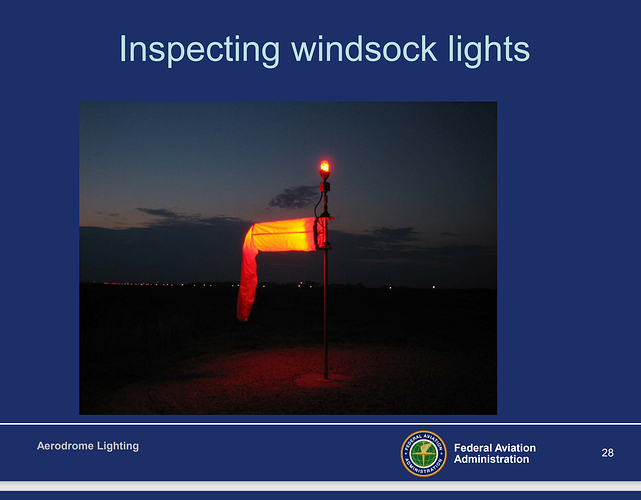Being a real pilot, I thought from day 1 this sim didn’t produce enough wind. That’s because I was looking at the windsocks, and notice they were all limp, as if there was no wind. The plane heading on approach disagreed, so this stood out.
I just tested this in the sim, after finding out what it should be. I could not confirm yet that the standard is the same in Europe, but the FAA and Canada match. You can read about it here.
Basically, each colored ring on a windsock represents 3 kts. So if the wind is 9 kts, the first three rings (red, white, red) will be horizontal, and the last two will be limp. 6 kts would mean the first two rings. 15 kts, then, as the windsock only has five rings, will fully extend it.
Considering how many people are flying VFR (me included!), properly working windsocks would make a significant contribution to realism, fun, and utility of this sim.
Thanks!
6 Likes
From my limited avaition experience I can also remember people telling me about the “3kt per stripe” rule, although I was not able to find any mention of that in my German theory books. So I looked through some relevant official ICAO documents to see what they have to say about wind cones. See the references below for details.
Summary
They refer to them as “wind direction indicators”, emphasising that their main purpose is to indicate directionality and not wind speed. Furtheremore they are not very clear on how they have to look like, they seem to only give recommendations and not require any specifics. (This is quite the opposite to the FAA  )
)
References
The following is an excerpt from ICAO Annex 14 "Aerodromes", Volume I "Aerodrome Design and Operations", Seventh Edition, July 2016.
CHAPTER 5. VISUAL AIDS FOR NAVIGATION
5.1 Indicators and signalling devices
5.1.1 Wind direction indicator
Application
5.1.1.1 An aerodrome shall be equipped with at least one wind direction indicator.
Location
5.1.1.2 A wind direction indicator shall be located so as to be visible from aircraft in flight or on the movement area
and in such a way as to be free from the effects of air disturbances caused by nearby objects.
Characteristics
5.1.1.3 Recommendation.— The wind direction indicator should be in the form of a truncated cone made of fabric
and should have a length of not less than 3.6 m and a diameter, at the larger end, of not less than 0.9 m. It should be
constructed so that it gives a clear indication of the direction of the surface wind and a general indication of the wind speed.
The colour or colours should be so selected as to make the wind direction indicator clearly visible and understandable from
a height of at least 300 m, having regard to background. Where practicable, a single colour, preferably white or orange,
should be used. Where a combination of two colours is required to give adequate conspicuity against changing backgrounds,
they should preferably be orange and white, red and white, or black and white, and should be arranged in five alternate
bands, the first and last bands being the darker colour.
5.1.1.4 Recommendation.— The location of at least one wind direction indicator should be marked by a circular
band 15 m in diameter and 1.2 m wide. The band should be centred about the wind direction indicator support and should be
in a colour chosen to give adequate conspicuity, preferably white.
5.1.1.5 Recommendation.— Provision should be made for illuminating at least one wind indicator at an aerodrome
intended for use at night.
The following is an excerpt from the ICAO Aerodrome Design Manual Part 4 - Fourth Edition 2004 - Visual Aids, Chapter 1, Landing information.
Landing Information
1.4.8 Wind direction indicators (wind socks) are important visual aids for all runway ends. Large wind direction indicators are particularly important at airports where landing information is not available through radio communications. […]
1.4.9 A fabric wind cone is generally the type preferred by pilots because it provides a general indication of wind speed. Cones that extend fully at wind speeds of about 15kt are most useful since this is the maximum corsswind landing component for [most] small aircraft.
I also stumbled upon illuminated windsocks 
Image
Yes, I could not find EASA specifications for windsocks. As you mentioned, it looks pretty “loose” on that side, which is unusual.
Nonetheless, considering the FAA and TC standard, I’m quite sure the vast majority of windsock manufacturers abide to that 3kt/stripe standard, perhaps even as their own, no matter what authority it’ll be used under.
Why is that unusual?
And yeah, FAA seem to be the only one to not just follow the international standard. 

